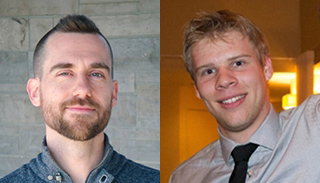Mini-Science public talk: The future of plastic

Jeffrey Farner (Biocolloid Research Group, Dept. of Chemical Engineering)
Patrick Julien (Friščić Research Group, Dept. of Chemistry)
We are draining our planet to make plastic, mainly for packaging. Today 8% of the world's annual petroleum production is converted into making plastics. Learn about plastic pollution in the environment today and the future of bioplastics and other cleaner and more energy-efficient green chemical synthesese.
Q: If you burn plastics do they become nanoparticles?
A: Burning things does cause the formation of small particulates some of which are nanoparticles, however these are generally different than traditional plastic nanoparticles, as they are either partially burned or have transformed into carbon (also called soot) nanoparticles. These particles are also commonly observed from diesel exhaust, and generally are a product of incomplete combustion. While these soot particles are of considerable health concern, modern industrial incineration facilities are specifically designed and extremely effective at removing these contaminants as well as other toxic or environmentally damaging emissions from burning plastic waste. This is one of the reasons that burning plastic (in a fire pit) is considered particularly bad for your health and the environment, but incineration can under the right circumstances be considered an environmentally friendly solution.
Q: What happens if you put the water flea back into a clean environment and get the nanoparticles expulsed over time?
A: Daphnia have the ability to depurate, or pass, things they’ve consumed but not been able to digest and use. As filter feeders, most of what is consumed, including plastics, will be depurated over time. However, some particles will make it through the digestive system and be retained within the body of the Daphnia. Those particles that are not depurated will then me more likely to negatively affect the Daphnia. Additionally, the ability of certain compounds or particles to remain in Daphnia is the basis for trophic transfer, in which species at lower positions of the food chain uptake a toxin, are consumed by something higher on the food chain, and then transfer that toxin to the higher species. In particularly concerning cases, this can lead to biomagnification where the higher species actually has a greater concentration of the toxin than whatever its food source is. The ability of micro and nanoplastics to undergo trophic transfer has been observed, and under which conditions this is most likely to occur is currently being investigated not only for Daphnia, but many other aquatic and marine filter feeders such as mussels.
Registration
This event is part of Mini-Science 2019. You must register for the full series of six talks to attend. Registration closes 19 March 2019.
› Register now
Mini-Science 2019: Science and the future!
Can McGill scientists help us build a better world? Learn how leading chemists, ecologists, paleontologists and even computer scientists at the University are helping us to understand how the future can be more just, more sustainable and inclusive.
- March 20: The future of food
- March 27: The future of nature
- April 3: The future of water
- April 10: The future of plastic
- April 17: The future of computers and AI
- April 24: The future of evidence and ecology
All talks are in English.
Transport and parking
Please refer to the Redpath Museum website for details.
Accessibility
We regret the venue for Mini-Science does not have provision for wheelchair access.
Mini-Science 2019 is brought to you by the Organizing Committee: Ingrid Birker, Hans Larsson, Anna Hargreaves, Joe Schwarcz and Tomislav Friščić. This series is made possible with generous support from Lorne Trottier.